Written for students in the USC Self-paced Astronomy courses
NOTE: This Unit assumes you have studied Unit 56.
The Learning Objectives and references are in the Self-Paced Study Guide
Essay on the General Theory of Relativity
by John L. Safko
A. General Principle of Covariance (or Only the Tides are Real)
Consider yourself in an elevator. You cannot see outside, so you must determine the nature of the surrounding universe by local experiments. You let go of a coin and it falls to the bottom of the elevator. Aha!, you say, I am at rest on Earth. But, you could be in a spaceship that is accelerating and far from any other object. This is shown in Fig. 57-1.
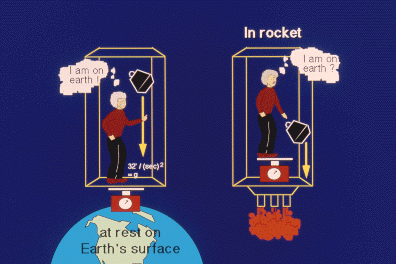
Fig. 57-1:
Locally being at rest on the Earth's surface is equivalent to being in a uniformly accelerated spaceship.
Consider the opposite case. You float from the floor and the coin does not fall when you release it. Aha!, you say again, I am in space far from any other body. But, you could be freely falling towards the Earth as shown in Fig. 57-2.
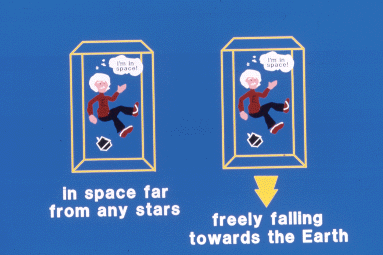
Fig. 57-2:
Locally freely falling towards the Earth is equivalent to being at rest with respect to the distant stars far from any gravitating body.
We see that gravity is different than other forces. You can make gravity completely disappear in small regions by freely falling. This means that a free fall frame is a perfectly good inertial frame. The only way we can detect the difference is to look for tidal forces which arise if the gravitational field is not perfectly uniform. But for any real gravitational field we can always make the region we consider (our elevator in this case) small enough so we cannot detect the tidal forces. So:
"For sufficiently small regions, the special theory of relativity is correct!!"
Einstein used these ideas to conclude that the laws of physics should be independent of the coordinate system used. Another way of saying this is that the laws of physics are generally covariant. Of course it is obvious that some coordinate systems may make a physical situation easier to describe and predict than others. All frames, however, are equally valid.
B. Gravity as Curved Spacetime
A region of spacetime where, in the old Newtonian view, gravitational forces exist, can thus be broken into smaller regions where an inertial frame is defined and the special theory of relativity works. There is no single inertial frame for the entire region.
Consider our elevator example again, only this time cut small windows in the elevator so light can pass through the elevator. Since we cannot tell the difference between being at rest in empty space or freely falling in a gravitational field, the light will pass through on a straight line, as shown in Fig. 57-3. Uniform acceleration would make the light appear to be on a curved path, since the elevator moves as the light passes through. But, we have argued that uniform acceleration is the same as being at rest in a gravitational field. Light passing through an elevator at rest in a gravitational field would appear to be on a curved path as shown in Fig. 57-4. The conclusion is that a gravitational field deflects light.
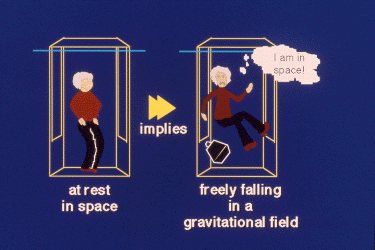
Fig. 57-3:
If you are at rest in a box, far from any gravitating body, light should pass through your box on a straight line. So light passing through the same box, if it were freely falling towards the Earth, would also appear to move on a straight line.

Fig. 57-4:
If you were uniformly accelerated in the illustrated box, you would expect light passing through your box to be deflected. This means that, if you were at rest in a gravitational field, the light would also be deflected. So a gravitational field deflects light.
Gravity has a local property -- if you freely fall, you no longer feel the effects of gravity. Gravity also has a global property. In the presence of gravity, two freely falling bodies will separate or approach each other (the tides). The only way we can reconcile the local property and the global property of gravity is to give up the geometry we assumed for spacetime. What does this mean?
Consider the following question. What do we mean when we say a line is straight? We probably mean the shortest path. The only way we could determine this is to use light to define a "straight" line. But we have seen that light may travel on curved paths. This forces us to generalize the idea of a "straight" line to what is called a geodesic and to generalize the geometry of spacetime. An example of a geodesic is a great circle on a sphere, such as a line of constant longitude. Another example would be a line of constant Right Ascension on the celestial sphere. A geodesic is the path that has the shortest distance between two given points.
The spacetime of the General Theory must locally have the same properties of the Special Theory. Light must travel on a null geodesic. A material object travels on a timelike path. If it is in free-fall, this path is a timelike geodesic. (See Unit 56.)
On a larger scale, gravity bends or distorts spacetime. These geodesics are the shortest path in this distorted spacetime. The interval of the Special Theory, ds, which was written as
ds2 = (c dt)2 - [(dx)2 + (dy)2 + (dz)2],
now becomes, in general,
ds2 = gtt (c dt)2 + 2 gtx dx dt + 2 gty dy dt + 2 gtz dz dt + gxx (dx)2 + 2 gxy dx dy + 2 gxz dx dz + gyy (dy)2 + 2 gyz dy dz + gzz (dx)2,
where the "g" terms could all be functions of t, x, y, and z. This very messy expression is just all possible combinations of the changes in the coordinates, taken two at a time, multiplied by functions of the coordinates. This is called a quadratic form.
For the special theory, the coordinates can be chosen so to make the "g"s all constant and zero except gtt = 1, gxx = gyy = gzz = -1. The "g" quantities are called the metric of the space in that coordinate system. The principle of equivalence forces us to conclude that although the "g"s are different in another coordinate system, they are describing the same spacetime. So the "g"s are describing something independent of the coordinate system -- the geometry of spacetime.
C. The General Theory of Relativity
When Einstein realized the preceding, he was able to take over an existing mathematical structure. This structure was the theory of Reimannian geometry which, until that time, was thought to be an abstract mathematical structure with no physical uses. With the mathematical tools of Riemannian geometry, Einstein was able to formulate a theory that predicted the behavior of objects in the presence of gravity, electromagnetic, and other forces. This theory is called the General Theory of Relativity. Avoiding the mathematical details, the theory gives relations, called the field equations, that say:
properties of the geometry = properties of the non-gravitational forces present. . . . . .(57-1)
In order to express the appropriate properties of the non-gravitational forces, we must also use the geometry on the right hand side of this relation.
Many physical theories are linear. By this we mean that if you add two sources, the resulting solution is the sum of the two solutions produced by the sources independently. The General Theory is highly non-linear since the geometric properties needed are non-linear and the geometry also appears on the right hand side of Eq. 57-1, as we define the needed properties of the non-gravitational forces. The results of non-linear theories can not be predicted by considering only small effects. For a non-linear theory the sum of two sources may produce a resultant solution which bears no resemblance to the individual solutions from the sources considered one at a time.
John Wheeler has described the results of solving Eq. 57-1 by saying
"Matter tells spacetime how to bend and spacetime returns the complement by telling matter how to move."
The General Theory is geometrical, that suggests drawing pictures to show what is happening to the geometry. Your text shows some such pictures near the end of Chapter 19. Figs. H 19-28 and 19-31 show what are called embedding diagrams. Two of the space dimensions are shown. The third dimension is not a space dimension. It is an attempt to show how the geometry differs from Euclidean. The bending is a measure of the curvature or distortion of space from flat. These diagrams can be very helpful in understanding what is happening, but don't let them mislead you.
The next step Einstein wanted to take was to completely eliminate the right hand side and express the entirety of physics as geometry. A theory expressing physics in terms of only one "object" (field) is called a unified theory. Except in special cases, neither Einstein nor anyone else has yet been able to find a theory that unifies gravity with the three other known natural forces.
Before we consider the experimental evidence that is consistent with the General Theory and some of the surprising predictions of the theory, let us briefly consider what has happened to our view of the nature of physical reality as we have taken the cosmic voyage. We developed the Newtonian world view, generalized it to the static spacetime of the Special Theory of Relativity and have now described the dynamic spacetime of the General Theory. These developments may seem very revolutionary, but they are evolutionary. The General Theory contains as a subset of its solutions the Special Theory. The General and Special theories contain as a subset of their solutions the solutions of the Newtonian theory. We have not given up concepts; we have only generalized them.
D. Tests of the General Theory
When first proposed, the general Theory of Relativity had no direct experimental underpinning. Now, many of us use equipment that could not work without using the General Theory. For example, the Global Positioning System (GPS) must use the predictions of the Special and General Theories. The GPS allows you, for a few hundred dollars, to buy a hand held instrument which can display your longitude, latitude and altitude to within 16 meters. (Or, for more money, you can get even better accuracy.) It also gives the time to within a few billionths of a second. The GPS consists of a set of 24 Earth-orbiting satellites with one or more atomic clocks. The entire system can only work if the predictions of the Special and the General Theories of Relativity are correct for weak gravitational fields.
D1. The Original Tests
Originally, three tests of the General Theory were proposed, whose results the theory seemed to properly predict. Between the early 1920's and the early 1960's, little experimental work occurred except to refine the measurements on the three experimental tests. Only in the last few years has the experimental side of general relativity blossomed. We will first discuss the three tests, which are called the classical tests of relativity, and then consider some recent developments.
The three classical tests of the general theory are
- the precession of the perihelion of Mercury
- the deflection of light
- the gravitational red shift of light. (This tests only one aspect of
the theory.)
Ideally, the orbit of a single planet about a star is an ellipse fixed in space. The presence of other planets changes (perturbs) this orbit as was discussed in Unit 17. For all natural orbits in the solar system. these changes are small. In the case of Mercury, we can consider the perturbed orbit as an ellipse which slowly precesses (rotates in its own plane) as is shown in Fig. 57-5 or in the text in Fig. H 19-31a. The orbit of Mercury is observed to precess about 5,600 seconds of arc per century. Since Mercury orbits the Sun about 700 times in a century, this is a small change in the orbit per orbital period. Newtonian physics could predict all this precession except 43 seconds of arc per century. The 43 seconds of arc was what the General Theory of Relativity predicts.
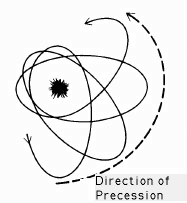
Fig. 57-5:
The orbit of Mercury is perturbed by the presence of the other planets and be small effects predicted by the General Theory. The observed precession of the perihelion is about 5,600 seconds of arc per century. After subtracting the Newtonian perturbations caused by the other planets, 43 seconds of arc remain. This is the amount predicted by the General Theory.
The second prediction is the deflection of light in a gravitational field as shown in the text Fig. H 19-31d. Since the effect is so small in the solar system, it can only be detected for light that just grazes the Sun. This is shown in Fig. 57-6. Solar eclipse expeditions took photographs that verified this prediction. Nowadays, with radio telescopes, we can measure this effect very accurately since the Sun occults several quasars and pulsars each year.
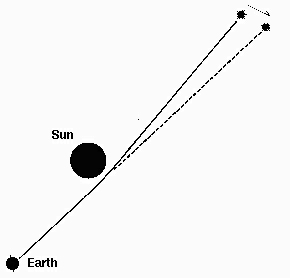
Fig. 57-6:
The deflection of light passing near the Sun. The figure highly exaggerates the 1".75 predicted by the General Theory.
The third prediction of the theory is light should lose energy as it climbed out of a gravitational field as shown in the text Fig. H 19-31b. This was verified in the spectra of some red stars; however, there was a lot of noise in the experimental data. The astronomical results are shown schematically in Fig. 57-7. In the late 1950's the effect was accurately verified by measuring the wavelength of light as it traveled up or down a tower on Earth.
Fig. 57-7:
The gravitational red shift of light was first measured in the spectra of cool red dwarf stars. Accurate measurements were made on the Earth's surface by sending light up and down a tower. The Mossbauer Effect, which allows the frequency to be measured very accurately, was used.
D2. Modern Experimental Tests
With the developments produced in the space age, there have been many new tests posed for the general theory of relativity. The theory seems to be meeting the tests carried out so far. Among the tests are details of the motion of the Moon as the Earth-Moon orbits the Sun, the time delay in light signals passing near the Sun; the motion of binary stars as they produce gravitational radiation, and the apparent existence of black holes in stellar and galactic systems. Among the proposed tests are the actual detection of gravitational radiation from supernovae and the predicted precession of gyroscopes in Earth orbit.
D2a. Gravitational Time Delay
The General Theory not only predicts a deflection of light as the light passes near a gravitating body, it also predicts that it should take the light longer to pass through the region near the star. The geometrical reason for this is shown in the text Fig. H 19-31c. This gravitational time delay was first measured in 1968 by I. Shapiro using radar signals reflected from the surfaces of Venus and Mercury. Since Mercury and Venus were near opposition when the experiments were done, the signals passed near the surface of the Sun, giving the greatest relativistic effects. Using a later launch of a Mariner probe, a transmitter on the probe bounced a signal off of the planets' surfaces as well as sending a signal directly to the receivers on Earth. Since the position of the planets were known better than the position of the Vikings, this improved the accuracy. When the Viking probes landed on Mars, the results were even more precise. Since then, the experiment has been repeated with other space probes and with the signals from the few pulsars that are occulted by the Sun. The pulsar timing signals, like the signals from the space probes, arrive slightly later than they would have if the Sun were not present. The results are in agreement with the predictions of the General Theory..
D2b. Gravitational Radiation
Another prediction of the General Theory is that moving a mass should produce gravitational radiation, just as moving an electric charge produces electromagnetic radiation (light). Unless the masses are moved at relativistic speeds the radiation produced is very weak. The least radiation produced by gravity is a quadrapole radiation, as shown in Fig. 57-8, rather than the dipole which can be produced by electromagnetic sources. This occurs because only positive mass seems to exist. Electric charges come with either positive or negative sign, allowing a simpler radiation pattern.
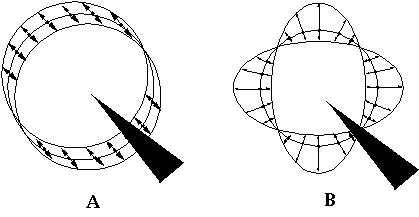
Fig. 57-8:
- The dipole distortion of a ring of charges through which a plane electromagnetic wave is passing.
- The quadrapole distortion of a ring of matter through which a plane gravitational wave is passing.
Gravitational radiation can be detected, in principle, on Earth by detecting sub-nuclear, but coherent, displacements in a massive block of material. A number of such detectors have been built. So far, what they have detected has not been confirmed as gravitational radiation. This is not surprising since the radiation should be very weak. They should have detected the gravitational radiation produced by Supervova 1987a in the Small Magellanic Cloud. (Shown in Fig. 57-9 as it first appeared and as it appears in 1995) However, all the groups had shut down for repair and improvements at the time the supernova occurred. They had shut down at the same time to avoid the possibility that one would detect a signal without independent verification by another group. It remains to be seen if this procedure will be followed in the future.
It should also be possible to detect changes in optical path lengths as gravitational radiation passes through an interferometer causing one arm to expand more than the other. One such interferometer is shown in Fig. 57-10. A set of devices, the LIGO (Laser Interferometry Gravity Observatory) project, are under construction and testing in California and Louisiana. Hopefully they will be functional by 2005.
Laser Interferometry Gravity Observatories
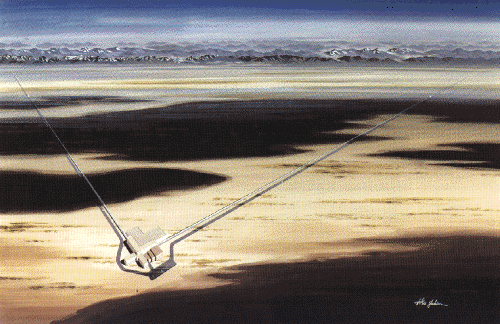
Fig. 57-10:
A sketch of one of the proposed Laser Interferometry Gravity Observatories. The ground was broken for construction in 1995.
Another possible method of detecting gravitational radiation is to examine the behavior of the source of that radiation. The argument is that in a close binary star system we would expect gravitational radiation to occur and the orbit of the stars about each other to decay as the gravitational radiation removes energy from the system. Several such systems have been studied whose models seem to be in agreement with theory. There are, however, two star systems, DI Her and AS Cam, whose behavior seems inconsistent with the theory. Since the observed data must be used to fit a model of these systems, it is not clear what is occurring. Future studies will resolve these problems either in favor of or against the general theory.
D2c. Gyroscope Precession
Both the special and the general theories predict that the axis of a rotating body that is orbiting another body should precess. The general theory predicts a slightly larger precession. The effect on the Earth's, or other planetary, axis is masked by irregularities in the rotation and classical precession of these axes.
One possible way of detecting this effect is to put a carefully shielded superconducting gyroscope in Earth orbit. Such a gyroscope is currently under construction at Stanford. It was originally scheduled for launch in 1986. This schedule has slipped to a current launch date after 2000.
E. Black Holes and Stellar Collapse
One of the more esoteric predictions of the general theory is the existence of black holes. A black hole is an object who mass is so large that light cannot escape from its surface. A simple argument for the existence of black holes is given in the next paragraph. As we shall see, the black holes predicted by the general theory are much more complicated.
E1. A classical argument for the formation of a Black Hole
In Units 3 and 13 we discussed the idea of escape velocity. For a body of mass M and size given by a radius R, the minimum velocity for a small body to escape from the surface is given by
| vescape = square root of(2GM / R). | . . . . . .(57-2) |
Laplace argued in the late 1700's, that if a star had enough mass for its size and if the speed of light is finite, we would expect that if we increased the mass of a star sufficiently light could not escape from its surface. Using c to represent the speed of light, M the mass of the star and R the radius of the star, Laplace was arguing that
c = vescape = square root of(2GM / R) . . . . .(57-3)
gives the mass to size ratio needed for a black hole. Combining Eqs. 57-1 and 57-2 gives the condition that a star traps all its emitted light when
| (2GM) / (Rc2) = 1. | . . . . . . (57-4) |
E2. The Exterior of a Spherical Black Hole
When we solve the exact spherically symmetric solution for a non-rotating source of gravity in the full General Theory of Relativity, we obtain the same result for the formation of a black hole. This R is called the Schwarzchild radius. For reasons we will discuss, the surface surrounding the source at R is called the event horizon.
If we use the mass of the Sun in Eq. 57-4, we find that a black hole with one solar mass would have a radius of 2.9 km. We can then divide Eq. 57-2 by itself using the solar values in the second case and expressing masses in solar masses and radii in km to get
| R = 2.9 km (M / MSun). | . . . . . .(57-5) |
For example, a 3.0 solar mass star would have a Schwarzchild radius of
R = 2.9 km x 3.0 = 8.7 km.
The black hole found in the general theory is much more complicated than Laplace's argument would suggest. It is not possible to measure the diameter, and hence the radius, by sticking a meter stick from one side to the other. The surface is a one way membrane that can only be entered, not exited. Even light cannot exit from inside this surface (see text Fig. H 19-27). So you could push in as long a stick as you can get and it will never get out, nor could you pull it back out.
This is expected, since you would have to move faster than light to exit from a distance closer than R from the center. Since even light cannot escape, no information about what is happening inside the surface can be communicated to the outside; that is, no events can be observed inside this surface. This is why we say the Schwarzchild radius defines an event horizon.
We define the radius, R, as the number defined by the area of the surface which just contains the event horizon. If we call this area Ao, then R is defined by
Ao = 4(Pi)R2.
Another property of the event horizon, which could not have been anticipated by Laplace, is the behavior of time near the horizon as as determined by different observers. To discuss this we must be careful to distingush a measurement with a given set of coordinates from what is "seen". We have already considered this problem in the Special Theory (Unit 56). Consider a freely-falling body which starts from rest far from the black hole and falls radially towards it.
The appropriate coordinates for a distant observer to use are called Schwarzchild coordinates. In these coordinate both space displacement and time displacement are distorted by the geometry near the horizon such that an infinite coordinate time will pass before the falling object will reach the horizon. Thus, a distant observer measures a slowing of the body as it reaches the event horizon. To this distant observer the body would, according to her coordinates, never cross the event horizon in a finite time.
An observer at rest near the horizon would measure the velocity of the falling body to be nearly the speed of light as it passes. An observer on the body will feel nothing unusual, except for possible tidal effects, as he crosses the event horizon it a finite time according to his clock and measures his relative speed as less than light.
This apparent paradox can be resolved by examining the full mathematical structure of the theory. What the distant observer says is an infinite time is only a finite time for an observer at rest near the horizon and for the observer on the falling body. As in Unit 56, note the difference between a measurement and "seeing."
E3. Collapse of a Spherical Star
Suppose we consider the spherical collapse of a non-rotating star. This is a highly simplified case, but it will show some of the features of a rotating, not quite spherical star. As a star collapses, the emitted light is red shifted and non-radial paths are curved to a greater and greater extent until the star reaches the diameter at which light emitted tangentially goes in circular orbit about the star. Your text shows this in Fig. H 19-31. This tangentially emitted light is trapped in circular orbit about the star. The light so trapped is called the photon sphere. As the star continues to collapse, less and less of the non-radial light emitted from the surface can escape. At the Schwarzchild radius even the radial light does not escape as shown in Figs. 57-11 and 57-12.
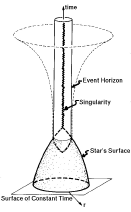
Fig. 57-11:
A sketch showing the formation of an event horizon as a star collapses to form a black hole Time is vertically upwards.
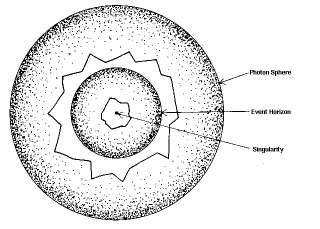
Fig 57-12:
A schematic of a black hole showing the singularity, the event horizon and the photon sphere. The photon sphere is the distance from a black hole that light emitted tangentially is just able to make a circular path. Any closer to the black hole and tangentially emitted light will spiral into the black hole.
If the black hole was formed by a collapsing star, the star, which is now interior to the event horizon, continues to collapse to the center, forming a singularity. Assuming the tidal effects outside the event horizon were not too large, an observer on a freely falling body would cross the event horizon without difficulty and in a finite time according to her clock. She would then have only a short amount of time before she comes too close to the center of the black hole and is crushed by the tidal forces as is shown in Fig. 57-13.
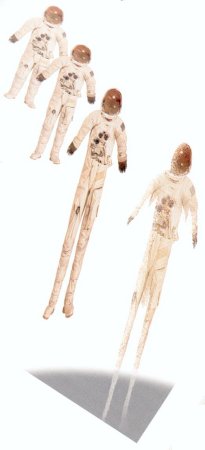
Fig. 57-13:
The event horizon of a Schwarzchild black hole may present no immediate problem; but, once you cross the event horizon, you have no way to go but towards the center. Getting too close to the center will result in tidal forces which can not be neglected. This will happen outside the event horizon for a small black hole. These forces are real, your feet will be accelerated relative to your head and your left and right sides will be squeezed together.
The distant gravitational field of a spherical star remains constant as this collapse occurs. Even after the star crosses the Schwarzchild radius the external curvature of spacetime remains. To a planet in orbit about the star before the collapse, the external gravity appears unchanged and its orbit is unchanged. In some sense the star becomes like the Cheshire cat in "Alice in Wonderland". The star (cat) is gone but its gravitational field (the grin) remains.
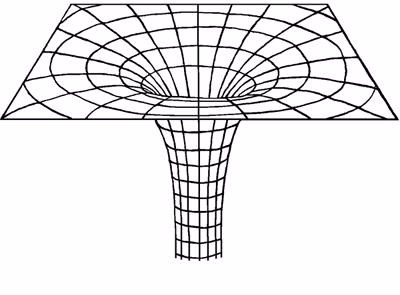
The star continues to collapse inside the Schwartzchild radius until it reaches a singularity at the center of symmetry. Some who study astrophysics suggest that at some point in this final collapse there may be new physics that prevents the singularity from forming. This may be a valid argument, but it does not prevent the event horizon from forming. A massive enough star will form the event horizon long before the density of the star reaches nuclear density. We have a good understanding of the behavior of matter at nuclear densities, so new physics will not prevent the formation of the event horizon and thus the black hole in those cases.
Since the black hole is much smaller than the star that formed it, it is possible for bodies to approach much closer to the center of the star, but to still stay outside the event horizon. We find that many of these new possible orbits are unstable. Any material body must move slower than light. Bodies on such orbits will spiral in towards the black hole and eventually be absorbed. Some orbits make many rotations about the black hole before they begin the spiring process. Orbits that existed before the collapse began are not effected; they remain as stable orbits.
At some point, either inside or outside the event horizon, the tidal effects will become large enough to tear the body apart. The most distant part of the body will be accelerated less than the part towards the center and the left and right sides will be squeezed together. These real forces will tear the body apart as was shown in Fig. 57-13 for a person. If it were atoms approaching the black hole, this tidal force makes an atom scream (radiate), just as you would. This will later be shown to provide a method of detecting a black hole.
F. Rotating Black Holes
If the collapsing star has some rotation, the nature of the collapse is changed, but the collapse not prevented. Information on the star¹s structure is radiated away. All that remains is the mass, the angular momentum, and possibly (but unlikely) the net charge. The rotating black hole is often called a Kerr black hole after the scientist who first formulated this solution to the field equations .

Fig. 57-14:
A schematic of the horizons and regions around a rotating black hole. There are two event horizons and two surfaces of infinite red shift. The singularity is now a ring about the axis. (after D"Inverno: Introducing Einstein's Relativity)
The resulting structure, shown in Fig 57-14, is much more complicated. There are two event horizons and two surfaces of infinite red shift. Each horizon touches one infinite reds shift surface at the axis of rotation Between the outer horizon and the outer surface of infinite red shift there exists a region called the ergosphere. In this ergosphere, a real particle must orbit in the direction of rotation of the black hole. Even light cannot travel against the rotation in the ergosphere.
Suppose you are in the ergosphere moving in the direction of rotation. Then you can enter and exit the surface of infinite red shift. If, while you are inside the ergosphere, you throw some mass towards the black hole, you can exit the outer surface with more energy than you had when you entered. This energy is provided by the rotational energy of the black hole. The black hole has less angular momentum after this interaction.
If you cross the outer event horizon, you must also cross the inner ecent horizon. You can enter but not exit. You will be forced towards the interior singularity. This singularity is not a point but is a ring in the plane perpendicular the the axis. Again the tidal forces become very large as a body approach the singularity, which would lead to the body's destruction.
The theory suggests that there are geodesics which pass through the ring and exit in another universe avoiding the singularity. This has been used as the deux ex machina in many science fiction books and movies. Studies of the formal solutions have shown that the presence of any finite sized body cuts off these possible paths. If something crosses the inner event horizon, it must eventually hit the singularity and be destroyed in the process.
G. Evidence for Black Holes
How can we detect an object which does not radiate? The answer lies in the behavior of light and matter near a black hole. If a black hole nearly lines up with a background star, we will see a displacement of the apparent position of the star or even multiple images. A very nearby black hole would even show as a black disk as illustrated in the computer generated Fig. 57-15. Black holes or other gravitating sources can even generate a ring of light if the positioning is exact.
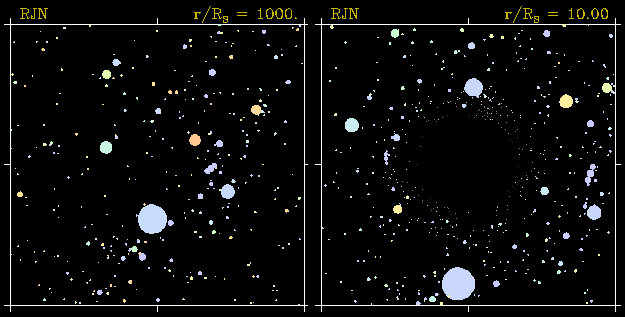
Fig. 57-15:
- Left: A computer generated image of the sky in the region of Orion as seen from Earth. The three stars of nearly equal brightness make up Orion's belt.
- Right: The same region of the sky with a black hole located at the center of the drawing. The black hole's strong gravity bends the light passing near it. This causes a noticable visual distortion. Each star in (a) appears twice in (b) on each side of the black hole. Near the black hole you can see the entire sky, as light is bent around the hole. (Robert Nemiroff (GMU, NASA)
Another method that will work for black holes surrounded by infalling matter is to detect the radiation produced by the tidal effect and the bumping together of nuclei as they crowd towards the hole. (See Fig. 57-13)
Since most black holes will be rotating, the same dynamics that led to the solar system being in a plane will lead to the matter around the black hole forming a disk. This disk is named the accretion disk. Far from the black hole the matter in the accretion disk can have a stable circular orbit. Nearer the center, there are no stable orbits. The matter in that part of the accretion disk must spiral in towards the horizons. This matter "screams" as it is squeezed and distorted by the tidal effects and as it hits other matter. The net effect is a massive emission of radiation at x-ray and other wavelengths. Some of the matter will even be ejected along the axis of rotation of the black hole producing jets of relativistically moving matter. This matter can interact with matter in the surrounding interstellar medium producing radio emission and visible light. Your text shows several such examples in Fig. H 25-22 through Fig. H 25-26.
In December 1995 NASA launched the X-ray Timing Explorer (XTE) into near Earth orbit to look for x-ray pulses as brief as a microsecond. Neutron stars, white dwarfs and black holes all can produce such radiation. Even before the 1995 launch x-rays were detected by previous satellites. One of these sources was detected in the constellation of Cygnus. This source also emits gamma rays as well as visible light. It is called Cygnus X-1 and is currently believed to be a black hole in orbit about a blue super giant as shown in text Fig. H 19-29. Some of the observational data includes periodic changes in the x-ray emission, periodic Doppler shifting of the visible star, and changes in the radiation from the accretion disk. When all the observational data is considered we model the system as including a black hole of at least 3.5 solar masses and possibly as large as 15 solar masses.
When your text was written there were at least 3 other binary star systems in our galaxy that are good black hole candidates. They, along with Cygnus X-1, are listed in Table 19-2 of the text. Since then V404 Cygni has also been shown to be a probable black hole. It is most likely that others have been added to the list since this essay was written.
The Hubble space telescope has enabled astronomers to produce images of cluster centers and of other galaxies that were not possible before.
This allows us to look for supermassive black holes that might have been part of the early formation of galaxies. Astronomers look for supermassive black holes there by the following methods:
- A rapid increase in stellar density as the center of the galaxy is
approached but without enough starlight being emitted from the very center.
- A highly energetic source at the center with highly energetic jets.
Such objects have been found in M32, M87, and M51 with masses ranging from 3 million to 3 billion solar masses. Your text has a picture of M32 in Fig. H 24-25. There is even evidence that there is a supermassive black hole in the center of our own Milky Way galaxy. This black hole is currently not active since little matter is falling onto it.
H. Wormholes
There is another type of black hole permitted besides those produced by the collapse of a star. These are topological black holes or wormholes in which two separate regions of spacetime (or even two separate spacetimes) are connected by a path that is not in the dimensions of the spacetime. An analogy is the handle of a cup which connects two separate portions of the cup. A model of a wormhole is shown in Fig 57-16.

Fig. 57-16:
A wormhole connecting two disjoint portions of spacetime. The distance through the wormhole may be shorter than the normal distances. If so, a wormhole traveler could cover regions of spacetime faster than light. Most likely such an attempt would close the wormhole and destroy the traveler.
Mathematically, wormholes are solutions or approximate solutions of Einstein's field equations without sources. The exact solutions depend heavily upon some assumed symmetry. It has been mathematically shown, in many cases, that if that symmetry is disturbed, the wormhole closes and becomes a singularity. A body trying to go through the wormhole would be such a disturbance.
Much use has been made of wormholes in science fiction as a means of rapid travel between different portions of spacetime without the need for speeds exceeding light. At this time we do not know if wormholes exist, but the theory does not seem to forbid them. So, remember the old adage "What is not forbidden, will occur."
I. Consequences on Cosmology
The general theory has had major effects on which cosmological theories we consider. In the large scale, cosmologists usually consider only cosmological theories that are consistent with the General Theory. This is what led the the statements such as: "the universe could be finite and not have a surface" and "there is no region outside a finite universe." To fit a cosmological model with observation we need the value of the deceleration parameter, qo. This value can only be determined from observational data after an assumption is made about the curvature of spacetime.
We still have conceptual problems with the very early universe. There is no consistent theory that successfully unites gravity and quantum mechanics Also we have no experimental data to guide us towards such a theory. So, our understanding of the very early universe remains problematic. The material discussed in the last two chapters of your text (Chapters 26 and 27) assumes, at least on the large scale, that the General Theory of Relativity is correct.
Hiçbir yazı/ resim izinsiz olarak kullanılamaz!! Telif hakları uyarınca bu bir suçtur..! Tüm hakları Çetin BAL' a aittir. Kaynak gösterilmek şartıyla siteden alıntı yapılabilir.
The Time Machine Project © 2005 Cetin BAL - GSM:+90 05366063183 - Turkiye / Denizli
Ana Sayfa /
index /Roket bilimi /![]() E-Mail /CetinBAL/Quantum Teleportation-2
E-Mail /CetinBAL/Quantum Teleportation-2
Time Travel Technology /Ziyaretçi Defteri /UFO Technology/Duyuru